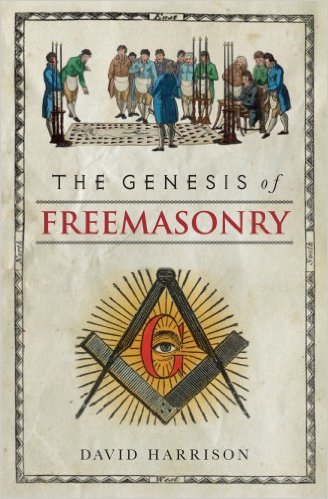En: Review by Ricky Pound of The Genesis of Freemasonry
Review by Ricky Pound of The Genesis of Freemasonry
‘The Genesis of Freemasonry’ is the first in a series of books by Dr David Harrison which trace themes in the history of Freemasonry. Harrison is a well established and respected author and a contributor to a number of publications on Freemasonry, together as a regular speaker on the lodge circuit. Published in 2008 (and revised and updated in 2015) Harrison’s attractive tome opens with the problematic question of Masonic origins. Since the eighteenth-century, numerous explanations (both plausible and far-fetched) have been put forward to explain the history and provenance of the Craft leading scholars such as Francis Yates to state: ‘’The origin of Freemasonry is one of the most debated, and debatable, subjects in the realm of historical enquiry”. Sensibly Harrison begins his study not with primordial Adam (who, according to Anderson’s mythical history in the ‘Constitutions’, must have “had the Liberal Sciences, particularly Geometry, written in his heart”), but through an overview of Freemasonry from the transition of what his calls ‘Operative’ to ‘Speculative’ masonry which he dates around 1640. Perhaps the question of utmost importance is what attracted non-stonemasons to stonemasons lodges in the first place? Perhaps here the antiquarian William Stukeley provides the definitive answer, drawn to Freemasonry because it led him to suspect: “it to be the remains of the famous mysterys of the Antients”.
Harrison points to the connection between the Royal Society, several founders of which were themselves Freemasons. In the course of his chapter on origins Harrison also mentions many of the other theories that have been claimed to play a part in the development of Freemasonry- the believed connection with the Knight Templar, the Rosicrucian myths (important influences on Moray and Ashmole), Hermetic (including alchemical) and Cabalistic influences.
For this reviewer, early Freemasonry was akin to a sponge, absorbing many diverse beliefs and philosophies to produce a multilayered intellectual tapestry of ideas that could inspire debate amongst its members, together with fostering a sense of companionship that comes from belonging to a mutually beneficial society.
Following these opening chapters Harrison includes a particular interesting section exploring the symbolism on Masonic gravestones. This is accompanied by a host of the author’s own photographs illustrating a variety of tombstones of Freemasons.
In the following chapters Harrison explains the importance of symbolism to Freemasonry (and particularly the importance of allegory and metaphor), much of which is derived from Solomon’s Temple. Harrison explains that for centuries decoding the dimensions of Solomon’s Temple had been an obsession among intellectuals with men such as Juan Bautista Villalpando, Isaac Newton and William Stukeley carrying out detailed studies of the Temple’s believed divine proportions. It is particularly interesting to note that a high point of interest in Solomon’s Temple in England was the 1720s and 30s which corresponded with the rapid growth of Freemasonry, both at home and abroad. In a later chapter, Harrison provides examples of the influence of Solomon’s Temple on eighteenth- century British architecture including Chiswick House in London which features Masonic and Hermetic ceiling paintings by William Kent and which has several rooms with dimensions based directly on the ‘Sanctum Sanctorum’ within the Tabernacle of Moses and the Temple of Jerusalem (dimensions converted from the Roman cubit to English feet).
In the chapter, ‘Freemasonry in Flux’, Harrison concentrates on the Dr John Theophilus Desaguliers and James Anderson, both Freemasons and two of the architects behind the formation of Premier Grand Lodge of England of 1717. That the formation of Premier Grand Lodge was political cannot be in doubt, following as it did the Jacobite rebellion of 1715 which was a serious wake-up call for the newly arrived Hanoverians and it’s Whig government. Anderson’s ‘Constitutions’ of 1723 was a manifesto for a new Masonic regime in which older ritual was either discarded and replaced with new ritualistic elements and inventions which often offended more conservative Masons. As Harrison shows, Premier Grand Lodge was soon to experience their own problems, with challenges of ‘antienticity’ from the direction of the York Grand Lodge who claimed to have a much more ancient pedigree back as far at least to King Athelstan.
The theme of discord and rebellion is extended by Harrison into the last three chapter which deals with the rival lodges in the guise of the York Grand Lodge and the successful challenge by the ‘Antients’ from 1751. These chapters provide an interesting introduction to the rival lodges, themes on which Harrison has successfully expanded upon the his later books ‘The York Grand Lodge’ (2014) and ‘The Liverpool Masonic Rebellion and the Wigan Grand Lodge’ (2012).
Harrison’s ‘The Genesis of Freemasonry’ is a handsome book. It contains a generous selection of photographs to accompany the scholarly text. There are, however, a number of printing errors which I have been assured have been rectified for the 2015 revised edition. Such errors are but niggles in a book that is informative and can be enjoyed by the Freemason and general reader alike.

